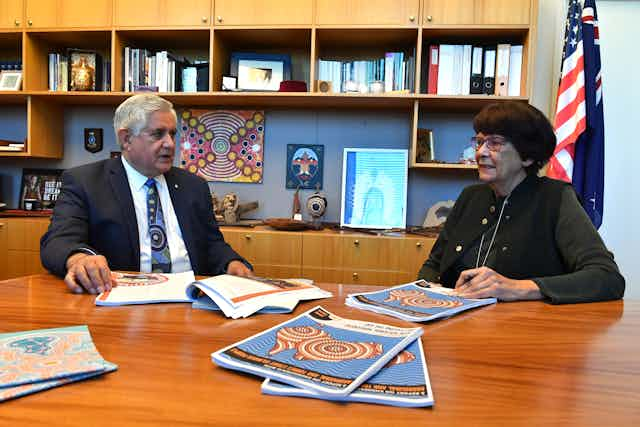The government will unveil 16 targets for Indigenous advancement, including ensuring the maintenance of strong relationships with land and culture, when Scott Morrison announces on Thursday a new national agreement on “Closing the Gap”.
Negotiated with Indigenous representatives as a partnership, the agreement sets out four priority reforms aimed at changing how governments work with Aboriginal and Torres Strait Islander people.
The reforms would:
-
build and strengthen structures to empower Indigenous people to share decision-making with governments
build Indigenous community-controlled sectors to deliver services to support closing the gap
transform mainstream government organisations to improve accountability and better respond to Aboriginal and Torres Strait Islander people’s needs
improve and share access to data and information to enable Indigenous communities to make informed decisions.
The agreement has been signed by all states and territories and the Indigenous Coalition of Peaks. The Morrison government believes it will lead to more success in closing the gap because of the shared drafting and the commitment by Indigenous representatives.
The 16 targets cover improving health, education, housing, employment and economic participation, lowering incarceration rates, ensuring the safety of families and households, and promoting social and emotional wellbeing.

They also include ensuring Indigenous people “maintain distinctive relationships with lands and waters” and that cultures and languages are strong.
The specifics of the targets will be spelt out on Thursday.
Four other targets – on family violence, access to information, community infrastructure and inland waters – are to be developed over the next year.
The old “Closing the Gap” plan, initiated by the Rudd government, had only mixed results, with progress on many of its targets falling short.
Morrison said the agreement was “a new chapter” in efforts to close the gap - “one built on mutual trust, shared responsibility, dignity and respect.
"The gaps we are now seeking to close are the gaps that have now been defined by the representatives of Aboriginal and Torres Strait Islander peoples. This is as it should be. This creates a shared commitment and a shared responsibility,” Morrison said.
“This is the first time a national agreement designed to improve the lives of Aboriginal and Torres Strait Islander people has been negotiated directly with Aboriginal and Torres Strait Islander representatives.
"By focusing our efforts on these more specific, practical and shared objectives we can expect to make much greater progress,” he said.
The Minister for Indigenous Australians, Ken Wyatt, said the best outcomes were achieved when Aboriginal and Torres Strait Islander Australians were equal partners with governments.
Pat Turner, lead negotiator for the Coalition of Peaks said: “For the first time, First Nations people will share decision-making with governments on Closing the Gap.
"Our country has unforgivable gaps in the life outcomes of Aboriginal and Torres Strait Islander people and other Australians in all aspects of life including mortality, chronic disease, disability rates, housing security, education, employment and wealth.
"The National Agreement represents a turning point in our country’s efforts to close these gaps.
"The Coalition of Peaks have always said that targets alone do not drive change. We have seen this from the past 10 years. It is the full implementation of the Priority Reforms by governments and a commitment to additional resources our communities need that will make the difference,” Turner said.
The agreement promises an increase in the level of reporting to improve transparency and accountability. The Productivity Commission will do an assessment of progress every three years and there will be an Indigenous-led review of change on the ground. There will also be annual reports tabled in federal, state and territory parliaments.
Update - the government on Thursday released the details of the Closing the Gap targets:
Close the Gap in life expectancy within a generation, by 2031
By 2031, increase the proportion of Aboriginal and Torres Strait Islander babies with a healthy birthweight to 91%
By 2025, increase the proportion of Aboriginal and Torres Strait Islander children enrolled in Year Before Fulltime Schooling (YBFS) early childhood education to 95%
By 2031, increase the proportion of Aboriginal and Torres Strait Islander children assessed as developmentally on track in all five domains of the Australian Early Development Census (AEDC) to 55%
By 2031, increase the proportion of Aboriginal and Torres Strait Islander people (age 20-24) attaining year 12 or equivalent qualification to 96%
By 2031, increase the proportion of Aboriginal and Torres Strait Islander people aged 25-34 years who have completed a tertiary qualification (Certificate III and above) to 70%
By 2031, increase the proportion of Aboriginal and Torres Strait Islander youth (15-24 years) who are in employment, education or training to 67%
By 2031, increase the proportion of Aboriginal and Torres Strait Islander people aged 25-64 who are employed to 62%
By 2031, increase the proportion of Aboriginal and Torres Strait Islander people living in appropriately sized (not overcrowded) housing to 88%
By 2031, reduce the rate of Aboriginal and Torres Strait Islander adults held in incarceration by at least 15%
By 2031, reduce the rate of Aboriginal and Torres Strait Islander young people (10-17 years) in detention by 30%
By 2031, reduce the rate of over-representation of Aboriginal and Torres Strait Islander children in out-of-home care by 45%
A significant and sustained reduction in violence and abuse against Aboriginal and Torres Strait Islander women and children towards zero
Significant and sustained reduction in suicide of Aboriginal and Torres Strait Islander people towards zero
By 2030, a 15% increase in Australia’s landmass subject to Aboriginal and Torres Strait Islander people’s legal rights or interests, and by 2030, a 15% increase in areas covered by Aboriginal and Torres Strait Islander people’s legal rights or interests in the sea
By 2031, there is a sustained increase in number and strength of Aboriginal and Torres Strait Islander languages being spoken.

